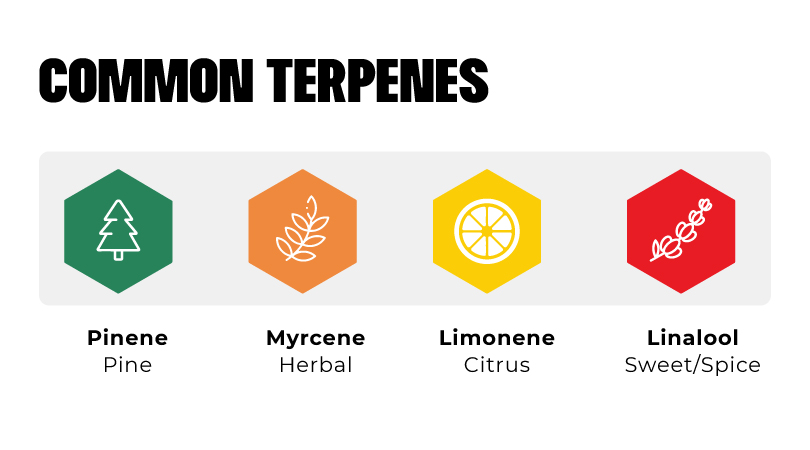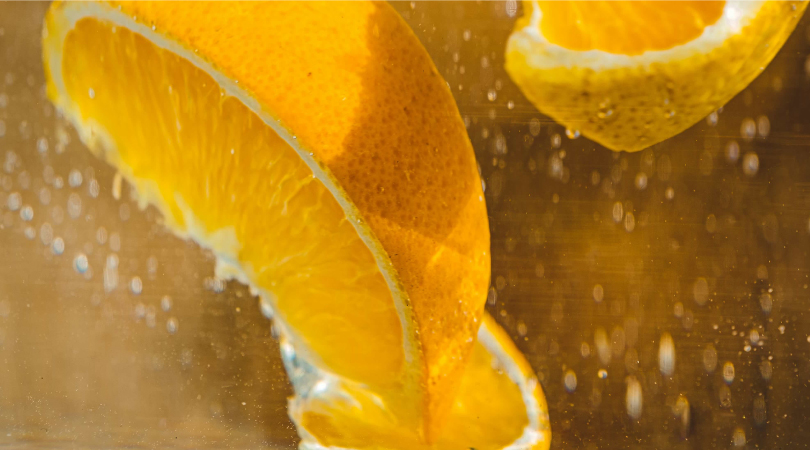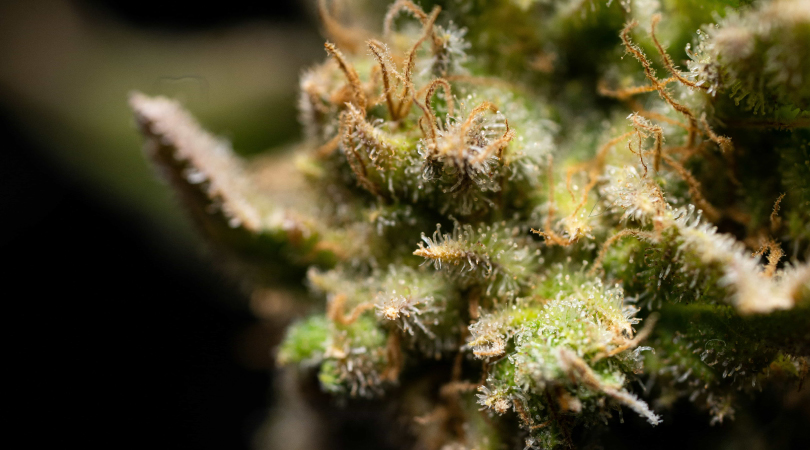You need to understand terpenes if you want to find the perfect high for you. Generally speaking, they shape the taste, smell, and even the effects of your cannabis. More importantly, they interact with cannabinoids like THCa and THC to influence how high you get. Keep reading to understand what cannabis terpenes are, how they work, their benefits, effects, and more!

What Are Cannabis Terpenes?
Terpenes in Nature: Terpenes are organic, natural compounds found in plants, not just cannabis. They shape the aromas and flavors of fruits, flowers, and herbs. The scent of pine, the citrusy aroma of an orange, or the fragrance of lavender? Yep, terpenes are responsible for all of those.
The Chemistry Behind Terpenes: At a molecular level, terpenes are hydrocarbons made up of small, 5-carbon “building blocks”. That is, terpenes are simply molecules made by connecting these blocks together in different patterns.
They are classified based on the number of these units, with monoterpenes (like limonene) being lighter and more volatile, while sesquiterpenes (like caryophyllene) are heavier and more stable.
Where Are Terpenes Present?
Terpenes are everywhere in nature. While cannabis is one of the richest sources, you’ll also find them in:
- Citrus fruits (limonene)
- Pine trees (pinene)
- Lavender (linalool)
- Black pepper and cloves (caryophyllene)
THCa Terpenes / THC Terpenes
Terpenes greatly influence the effects of THCa and THC you’ll experience. THCa itself is non-psychoactive (as is non-activated weed), but when it’s heated (through smoking, vaping, or cooking), it converts into THC, which gets you high. THCa/THC terpenes will shape how this high feels; some of them will make you feel a more euphoric kind of high, while others will have more sedative-like effects.
What Do Terpenes Do?
OK, we now know that terpenes play a big role in adding flavor and aroma to plants, but when consumed, they also interact with your body, making it react in all sorts of ways. In the case of THCa and THC, terpenes can enhance relaxation, boost your energy levels, or even help you focus on creative activities.
Terpenes Benefits
Improve Your Mood and Reduce Stress Levels:
Certain terpenes can interact with brain receptors to make you feel calmer and carefree.
Pain Relief and Inflammation Reduction:
Many terpenes are being studied for their anti-inflammatory and pain-relieving properties. Early research suggests they can help reduce pain and swelling by targeting some pathways in the body, which means they could potentially offer relief from conditions like arthritis and chronic pain.
Sedation and Relaxation:
Some terpenes have sedative effects, setting you up for a relaxing and solid night’s rest.
Improved Focus and Alertness:
Other terpenes can enhance cognitive function, promoting alertness, focus, and memory. If you’ve ever used cannabis to study for a final or to prepare an end-of-term project, you should thank terpenes for your deep focus.
Enhancing Cannabinoid Effects:
Terpenes play a crucial role in the “entourage effect,” where they interact synergistically with cannabinoids like THC and CBD. This interaction can potentially enhance the therapeutic effects of cannabis, making your overall experience more potent and all-encompassing.

How Do Terpenes Work?
Terpenes interact with cannabinoid receptors and other neurotransmitter systems in your body, influencing mood, your senses’ perception, and even physical sensations. Some bind to receptors directly, while others modulate how cannabinoids like THC affect you, which is why they can give such different effects from one another.
Key Cannabis Terpenes and Their Effects
Myrcene
Myrcene is one of the most abundant terpenes in cannabis. It has an earthy, musky, and slightly fruity aroma, similar to cloves, grapes, and mangoes. It’s also found in hops, thyme, and lemongrass.
Myrcene Potential Benefits:
-
- Sedative and Relaxing: Myrcene is believed to have sedative and muscle-relaxant properties, potentially contributing to the “couch-lock” effect associated with some cannabis strains.
- Analgesic: Some research suggests myrcene may have pain-relieving properties.
- Anti-inflammatory: It may also have anti-inflammatory effects.
- Enhancing Cannabinoid Absorption: Myrcene may increase the permeability of the blood-brain barrier, potentially allowing cannabinoids to reach brain receptors more effectively.
Limonene
As its name suggests, limonene has a strong citrusy aroma, like lemons or oranges. Apart from cannabis, it is also found in citrus peels, as well as in peppermint and rosemary.
Limonene Potential Benefits:
-
- Boosting Your Mood: Limonene is known for influencing your mood and attitude, meaning it is one of the terpenes responsible for your feel-good spirit.
- Antifungal and Antibacterial: It is suggested to have antifungal and antibacterial properties.
- Anti-anxiety and Antidepressant: Limonene may help alleviate anxiety and depression symptoms.
- Improved Absorption of Other Terpenes: Limonene may increase the absorption of other terpenes.
Caryophyllene
Caryophyllene has a spicy, peppery, and woody aroma, similar to black pepper, cloves, and cinnamon. It’s also found in black pepper, cloves, and hops.
Caryophyllene Potential Benefits:
-
- Anti-inflammatory: Caryophyllene interacts with the CB2 receptors of the endocannabinoid system, potentially reducing inflammation.
- Pain-reducing effects: It may also have pain-relieving properties.
- Gastroprotective: It may have protective effects on the gastrointestinal system.
Additional Terpenes:
-
- Pinene: Piney aroma, may promote alertness and memory retention.
- Terpinolene: Woody, floral, and citrusy aroma, may have sedative and antioxidant effects.
- Linalool: Floral and lavender-like aroma, may have relaxing and anti-anxiety effects.
- Humulene: Earthy and woody aroma, may have anti-inflammatory and appetite-suppressing effects.
Terpenes and Cannabinoids
Cannabinoids and terpenes are the perfect mix behind the many different cannabis effects.
On one side, cannabinoids, the main chemical compounds within the plant, interact with your body and influence some physiological processes, like your sleep cycle, and pain sensations. Among these cannabinoids, THCa, the non-active component of cannabis, transforms into THC when heated, giving you the “high” effects you are looking for. Other cannabinoids like CBD are popular for their potential therapeutic benefits without the “high.”
However, you won’t fully understand how cannabis works and know how to choose the best product for you if you don’t explore terpenes.
Terpenes, which as we learned before are the aromatic compounds responsible for cannabis’s aroma, also have a key role in influencing and enhancing the effects of cannabinoids, and their interaction is known as the “entourage effect.” This means that when terpenes and cannabinoids work together, they create a richer, more nuanced experience.
That is why when you use cannabis products that have both cannabinoids and terpenes (full-spectrum), you get a more complete and intense effect than using just one part of the plant.
Sativa vs. Indica vs. Hybrid: Terpene Profiles
| Terpene | Common Aroma | Potential Effects | Predominant in |
| Myrcene | Earthy, musky, herbal | Sedative, relaxing, pain relief | Indica |
| Limonene | Citrusy, fresh | Uplifting, mood-boosting, stress relief | Sativa |
| Caryophyllene | Spicy, peppery | Anti-inflammatory, pain relief, anxiety relief | Indica and Hybrid |
| Linalool | Floral, lavender | Calming, sedative, sleep-promoting | Indica and Hybrid |
| Pinene | Piney, fresh | Focus, alertness, bronchodilator | Sativa |
| Humulene | Earthy, woody | Anti-inflammatory, appetite suppression | Indica |
Terpenes and the Entourage Effect
As mentioned before, the entourage effect is how the various compounds in cannabis, including cannabinoids and terpenes, work together to give you stronger and more comprehensive effects.
Specifically, terpenes interact with the body’s endocannabinoid system (ECS) alongside cannabinoids, influencing how those cannabinoids bind to receptors and produce their effects.
For example, a terpene like myrcene can enhance the sedative properties of THC, leading to a more relaxing experience. On the other hand, limonene can promote a more uplifting and energetic effect, potentially counteracting the sedative tendencies of some cannabinoids.
How to Choose the Right Cannabis Terpenes for You
1. Define Your Desired Effects:
-
- Relaxation: If you’re looking for relaxation and stress relief, consider terpenes like myrcene and linalool. Myrcene is known for its sedative properties, while linalool offers calming, lavender-like effects.
- Energy and Focus: For an uplifting and energizing experience, look for terpenes like limonene and pinene. Limonene provides a citrusy boost, while pinene can promote alertness and focus.
- Pain Relief and Inflammation: If you’re seeking pain relief, beta-caryophyllene is a good option. It interacts with the endocannabinoid system to reduce inflammation and pain.
2. Pay Attention to Aroma:
The aroma of cannabis is a strong indicator of its terpene profile. Trust your nose! If a particular scent appeals to you, it’s likely that you’ll enjoy the effects of those terpenes.
3. Check Product Labels and Lab Test Results:
Reputable cannabis dispensaries and brands provide lab reports that detail the terpene content of their products. This information can help you make informed choices.
4. Start Low and Go Slow:
When trying new terpene profiles, start with small amounts and gradually increase your dosage as needed. This allows you to gauge how different terpenes affect you.
5. Keep a Journal:
Track your experiences with different terpenes, noting the effects you experience and your preferred dosages. This can help you identify your favorite terpene profiles.

Terpenes FAQs
Do Terpenes Get You High?
Not on their own, but they shape the high you get from THC.
How Are Terpenes Extracted from Cannabis?
Common methods include steam distillation, CO2 extraction, and solvent-based techniques.
How Do I Know What Terpenes Are in My Weed?
Many dispensaries provide terpene profiles in their product descriptions. Lab-tested cannabis products often list terpene content, so check the packaging or ask your budtender.
What’s the Difference Between Terpenes and Terpenoids?
Terpenes are natural hydrocarbons, while terpenoids have been chemically modified, often through oxidation.
How Do Different Terpene Profiles Affect Cannabis Strains?
Each strain’s terpene profile influences its aroma, flavor, and effects, from sedating to energizing.
Are Terpenes Safe to Consume?
Yes, when used in appropriate amounts. They are naturally found in food and plants.
Do Terpenes Make Cannabis Stronger?
They don’t increase THC levels but can enhance or modify the effects of THC.
Final Thoughts
Terpenes are more than just flavor and aroma—they play a crucial role in shaping the effects of cannabis. Whether you’re looking for a euphoric high, deep relaxation, or pain relief, understanding terpenes will help you find the perfect strain for your needs. Visit our shop and find the THCa product with the right terpenes for you!
